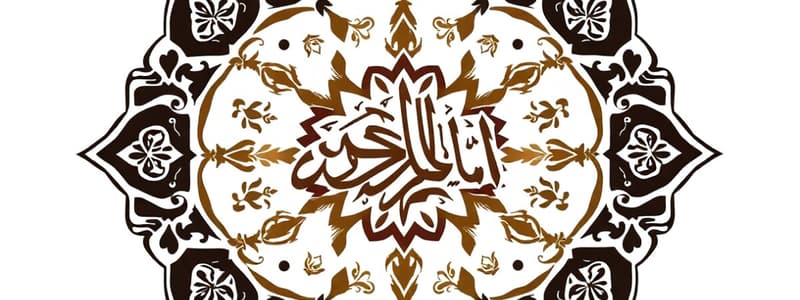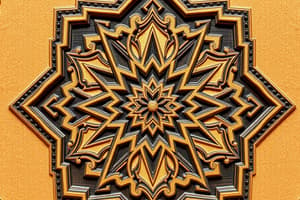Podcast
Questions and Answers
أي من الأساليب التالية يتسم باستخدام أنماط هندسية معقدة وعناصر زخرفية مزهرة غالبًا ما تُرى في المساجد؟
أي من الأساليب التالية يتسم باستخدام أنماط هندسية معقدة وعناصر زخرفية مزهرة غالبًا ما تُرى في المساجد؟
- فنون الزخرفة الهندسية الحديثة
- الأسلوب الموريسي
- الأسلوب العثماني (correct)
- النمط المسيحي
ما الذي يتميز به أسلوب الزخرفة في الفترة الإسلامية المبكرة؟
ما الذي يتميز به أسلوب الزخرفة في الفترة الإسلامية المبكرة؟
- استخدام الأشكال الطبيعية مع ظهور مجرد (correct)
- الهندسة المعمارية الرومانية
- وصف مبتكر للخيال
- الأنماط المزهرة فقط
كيف يعكس الاستخدام الزخرفي الوضع الاجتماعي للمباني؟
كيف يعكس الاستخدام الزخرفي الوضع الاجتماعي للمباني؟
- لا يؤثر على التصميم بشكل مُعين
- يظهر تفرد وفخامة البناء (correct)
- يعتمد فقط على العاملين في مجال البناء
- يعبر عن نوع المواد المستخدمة فقط
ما الذي يعكسه الفن الزخرفي الإسلامي بشكل رئيسي؟
ما الذي يعكسه الفن الزخرفي الإسلامي بشكل رئيسي؟
ما الذي يعرف به فن التصوير المصغر الفارسي؟
ما الذي يعرف به فن التصوير المصغر الفارسي؟
ما الذي يميز الزخرفة الإسلامية من حيث الأنماط التي تحتويها؟
ما الذي يميز الزخرفة الإسلامية من حيث الأنماط التي تحتويها؟
ما هو الدور الذي تلعبه الخط العربي في الزخرفة الإسلامية?
ما هو الدور الذي تلعبه الخط العربي في الزخرفة الإسلامية?
ما هي الرمزية التي غالبًا ما تعبر عنها الأنماط الزخرفية في الفن الإسلامي؟
ما هي الرمزية التي غالبًا ما تعبر عنها الأنماط الزخرفية في الفن الإسلامي؟
أي من المواد التالية تُستخدم عادة في الزخرفة الإسلامية، وخاصة في بناء المساجد؟
أي من المواد التالية تُستخدم عادة في الزخرفة الإسلامية، وخاصة في بناء المساجد؟
ما الذي يميز الزخرفة الإسلامية عن الأنماط الأخرى من حيث تمثيل الطبيعة?
ما الذي يميز الزخرفة الإسلامية عن الأنماط الأخرى من حيث تمثيل الطبيعة?
ما الذي يعبر عن التوازن في الزخرفة الإسلامية؟
ما الذي يعبر عن التوازن في الزخرفة الإسلامية؟
أي من الخصائص التالية لا تعتبر جزءًا من الزخرفة الإسلامية؟
أي من الخصائص التالية لا تعتبر جزءًا من الزخرفة الإسلامية؟
ما هي التقنية الأساسية التي تستخدم في النقش على الخشب في الزخرفة الإسلامية؟
ما هي التقنية الأساسية التي تستخدم في النقش على الخشب في الزخرفة الإسلامية؟
Flashcards
فترة الإسلام المبكر
فترة الإسلام المبكر
تظهر الأشكال الطبيعية ولكن يبدأ التجريد بالظهور.
أسلوب المغاربي
أسلوب المغاربي
يتميز بنمط متكرر وزخارف نباتية وأشكال هندسية خاصة بالعمارة.
أسلوب عثماني
أسلوب عثماني
يتميز بالفسيفساء المعقدة والأنماط الهندسية والنقوش الخطية.
الزخرفة في اللوحة المصغرة الفارسية
الزخرفة في اللوحة المصغرة الفارسية
Signup and view all the flashcards
الزخرفة وعلاقتها بالعمارة
الزخرفة وعلاقتها بالعمارة
Signup and view all the flashcards
زخرفة إسلامية
زخرفة إسلامية
Signup and view all the flashcards
أنماط هندسية
أنماط هندسية
Signup and view all the flashcards
خط عربي
خط عربي
Signup and view all the flashcards
أنماط زهور
أنماط زهور
Signup and view all the flashcards
أشكال تجريدية
أشكال تجريدية
Signup and view all the flashcards
أسلوب زخرفي
أسلوب زخرفي
Signup and view all the flashcards
معنى روحي
معنى روحي
Signup and view all the flashcards
تقنيات ومواد
تقنيات ومواد
Signup and view all the flashcards
Study Notes
Introduction to Islamic Ornamentation
- Islamic ornamentation is a rich and diverse artistic tradition, marked by distinctive aesthetic principles and symbolic meanings.
- It's deeply rooted in Islamic theology, reflecting spiritual values and moral principles.
- The art evolved through varied cultural exchanges and interactions across the Islamic world.
Key Characteristics of Islamic Ornamentation
- Geometric Patterns: Intricate and repeating geometric patterns are prominent, often symmetrical, creating appealing and complex visual narratives.
- Calligraphy: Exquisite and stylized Arabic calligraphy, frequently incorporating Quranic verses, is a crucial element. This carries deep spiritual and aesthetic significance.
- Floral Motifs: Intricate floral patterns, often stylized, are common, signifying natural beauty, harmony, spiritual growth, and purity.
- Abstract Forms: Designs sometimes include abstract forms representing spiritual or cosmic themes, balancing geometric and floral elements.
- Stylization: Emphasis is on stylization rather than realism, adapting natural forms into symbolic representations.
Symbolic Meanings and Interpretations
- Spiritual Significance: Islamic designs carry symbolic meanings linked to spiritual concepts like Paradise, divine creation, and the oneness of God (Tawhid).
- Aesthetic Harmony: Ornamentation aims for balance between visual harmony and spiritual symbolism, reflecting a connection to the natural world and the divine.
- Cultural and Historical Context: The meaning of design elements can vary based on specific historical and cultural contexts within the Islamic world.
Materials and Techniques
- Tiles (Iznik ceramics, etc.): Pottery, particularly tiles, frequently decorates buildings and mosques, showcasing skilled craftsmanship and vibrant colours.
- Metalwork: Metalwork often features intricately designed geometric patterns, calligraphy, and floral motifs, showing high metalworking skill.
- Wood Carvings: Wooden surfaces are decorated with carvings that incorporate floral and geometric patterns, sometimes inlaid with different materials for depth.
Examples of Islamic Ornamentation Styles
- Early Islamic Period: Showcased more natural forms, with abstraction developing over time.
- Moorish Style: Features repeating patterns, stylized floral motifs, and geometric patterns, mainly in architecture.
- Ottoman Style: Noteworthy for elaborate mosaics, intricate geometric patterns, and exquisite calligraphy and floral elements, found in mosques and palaces.
- Persian Miniature Painting: Combines calligraphy, miniature painting, and vibrant colours.
Relationship between Ornamentation and Architecture
- Islamic ornamentation is deeply linked to architecture, decorating buildings, mosques, and palaces to create a beautiful and spiritual atmosphere.
- The use of ornamentation often reflects the social status of the structure.
Importance and Impact
- Islamic ornamentation demonstrates exceptional skill, artistry, and precision, reflecting profound Islamic beliefs and aesthetic ideals.
- It continues to influence contemporary design globally, making it part of global design history.
Studying That Suits You
Use AI to generate personalized quizzes and flashcards to suit your learning preferences.




